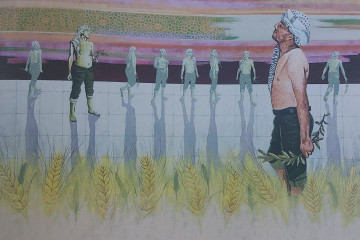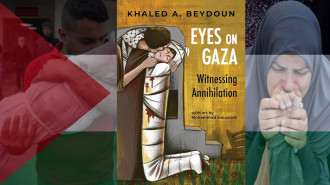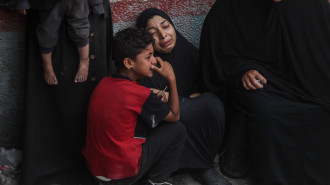

“When there is a military escalation in Gaza, the inhabitants of the Strip stop practising any type of artistic activity to follow the developments of the war. This time is not like the others: we are experiencing an unprecedented event that has led to terrible transformations. The war has been going on for a long time and the conflict seems endless. I chose to release the burden inside me through drawings and diaries that document the various stages of the genocide of the Palestinian people, using the tools I have at my disposal: a notebook, pencils and black ink pens.”
Thus begins the dramatic tale of Mohammed Alhaj, a Palestinian artist living in Gaza who participated in the art collective Foreigners in Their Homeland, organised by the Palestine Museum US at Palazzo Mora in Venice.
The exhibition, curated by Faisal Saleh and running until November 24, includes the works of 26 Palestinian artists, shedding light on the suffering conditions of their people, forced to live in an apartheid situation.
Mohammed Alhaj and Maisara Barud are the only artists from Gaza exhibiting in Venice while simultaneously trying to survive Israeli bombings.
Recently, Mohammed has been drawing with ink on paper, representing the situation he's experiencing in his works.
It was through this that the series Diary of a Palestinian Displaced Person was created and exhibited at Palazzo Mora.
These are black-and-white drawings in which Mohammed depicts scenes of daily survival, tent camps and the flow of refugees travelling from north to south in a desperate attempt to escape the bombings in Gaza.
The visual messages document life under the bombs and in a burning tent.
“On some occasions, I have created fictional characters that depict the typical Palestinian: shirtless, wearing only a keffiyeh and jeans, symbolising their bare resistance," Mohammed tells The New Arab.
"Other times, I have created abstract and cubist-style drawings with symbolic meanings related to the displacement of refugees in the Al-Mawasi area of the Strip. I managed to create a heritage of work with great artistic value and some of these works are exhibited in the ongoing exhibition in Venice.”
Curator Faisal Saleh not only included Mohammed's latest drawings produced between the end of 2023 and the beginning of 2024, but also a piece that highlights the use of colours to convey Palestinians' sense of disorientation caused by forced displacement, titled The Truth Is With You and The Land Is With Them.
“The drawing, a mural of two metres by 1.30, describes the condition of alienation felt by Palestinians even within the occupied territories," Mohammed explains.
"Our people live in a state of disorientation and helplessness, unsuccessfully seeking paths to safety. Unfortunately, the mural, of which we have exhibited a printed copy in Venice, was burned and destroyed along with the other works that were in my studio in Gaza City, devastated by the bombs.
"Many artists were killed and their art destroyed. I lost everything, including my tools.”
Mohammed was born in Tripoli, Libya, in 1982 to a Palestinian family and returned to Palestine at the age of 13. When the war broke out, he was living in Gaza City. Then, with his wife and four children, he was forced to flee to the Nuseirat refugee camp in the centre of the Strip.
Subsequently, he moved to the Al-Mawasi area, located on the sea between the cities of Khan Yunis and Rafah.
“I stayed there for about three months, then returned to the Nuseirat camp, where I currently reside with my family and my father," he says.
"My mother died at 82 due to a severe illness. We are now well and relatively safe but danger is always lurking, which is why I want to leave Gaza. We are waiting for the Rafah crossing to reopen to find a safe haven.”
Mohammed's canvases, sculptures, bas-reliefs and murals were all destroyed, burned and reduced to ashes. The only traces of his artistic work are some photos he had previously published on his social media pages, in addition to the pieces preserved at the Palestine Museum US.
“Every phase of an artist’s life is characterised by a unique and special experience reflected in the artworks," Mohammed tells The New Arab.
"I have gone through various phases that encompass drawing, colour painting, sculpture, collage, printmaking and engraving. Each work results from an experience that is different in form and content from the previous one.
"The war has expanded my intellectual and visual horizons, allowing me to observe its effects in daily life, strengthening my expressive capacity and finding new ways to express the situation in Gaza which, paradoxically, represents fertile ground for creativity.”
In 2022, Mohammed contributed to the collateral event of the Venice Biennale Arte titled From Palestine With Art, proposed by the Palestine Museum US.
"Due to political pressure on the Biennale's organisation, the exhibition Foreigners in Their Homeland was not included in this year's event activities," Mohammed explains.
"The Palestinian project that was presented by the Palestine Museum US was rejected. A 'double standard' emerged: the Israeli project was approved and included in the Biennale's activities."
Nevertheless, thanks to the exhibition set up in Venice, Mohammed can represent Palestinian art internationally.
“Investing in art is no less important than resistance activity and political action. The Palestinian people's struggle is a just cause that deserves to be supported.
"I believe that art is a means to narrate the Palestinian story: we don't need someone to translate our art to the world, the common denominator among people is the visual language, which is easy to read and understand," the artist concludes.
Giovanni Vigna is a freelance Italian journalist with a focus on Middle Eastern and global politics




 Follow the Middle East's top stories in English at The New Arab on Google News
Follow the Middle East's top stories in English at The New Arab on Google News


